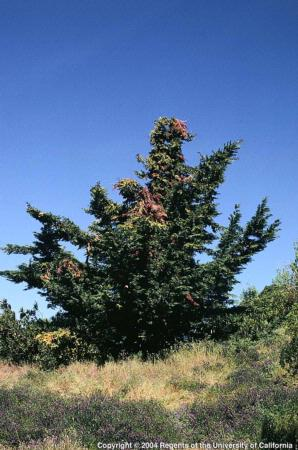Cypress Disease
By Leonard Cicerello UCCE Master Gardener
Why are my Cypress dying in my front yard? Joe B. Paso Robles
A study published in 2011 by UC Berkeley and Italian researchers may have solved a decades-long mystery behind the source of a tree-killing fungus that affected six of the world's seven continents. The pathogen, Seiridium cardinale, also known as Cypress Disease or Cypress Canker, was likely introduced from California either in the south of France or in central Italy 60 to 80 years ago. Its introduction devastated the region's iconic Italian cypress trees. Researchers found historical catalogues of large commercial nurseries in Italy and France and found records of mature Monterey cypress trees for sale during the late 1920s and 1930s. The records indicated significant imports of the California trees and their seeds during that time.
Seiridium cardinale was first identified in California's San Joaquin Valley in 1928. The fungus attacks trees in the cypress family by entering through cracks in their bark and producing toxins that wreak havoc with the flow of sap, limiting the supply of water and nutrients. The cracks in the bark could be caused by pruning cuts, boring insects, or weather damage. The spores spread by wind and water splash. Symptoms include dieback beginning from the top of the tree or branches browning and dying throughout the canopy. A branch can change color over a period of days.
You may see thin, elongated cankers on the stems and branches. These cankers cause twig and branch dieback. Most cankers are wounds, slightly sunken, with raised margins, and they may be discolored, dark brown to purple. An infected tree with cracked bark often has extensive resin that flows down the diseased branches and trunk. Once most of the canopy has turned brown, that limb or tree will almost certainly die. The whole limb or tree should be removed and properly disposed of.
The principal hosts for cypress canker are Monterey cypress, Italian cypress, Leyland cypress, Lusitania cypress, and Arizona cypress. It is best not to replant new cypress immediately following the removal of diseased trees. No specific cure exists. The best you can do is supply adequate water, minimize soil compaction, apply a thin layer of mulch, and avoid wounding the tree.
